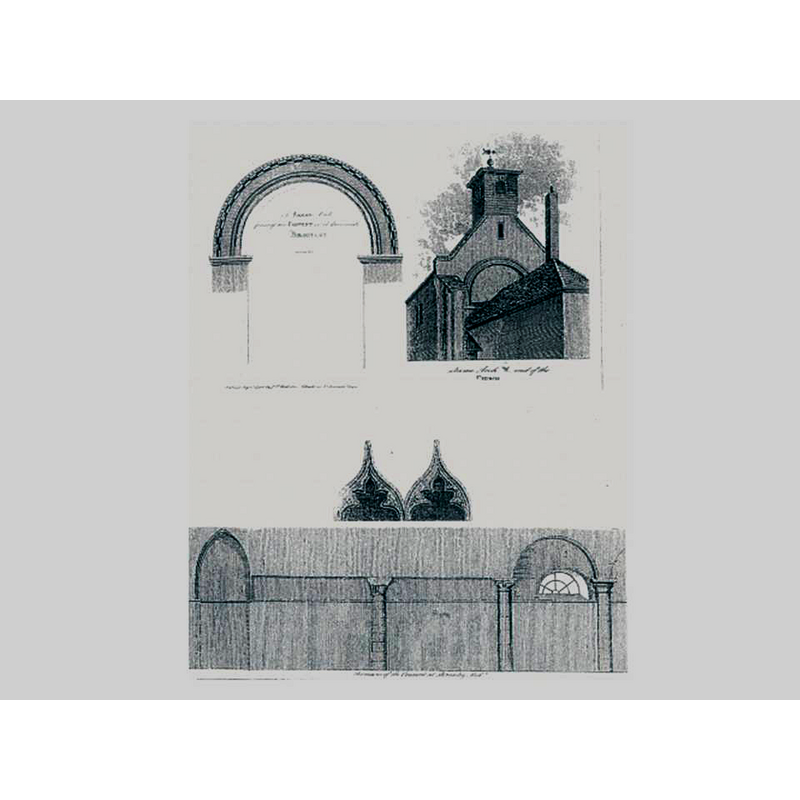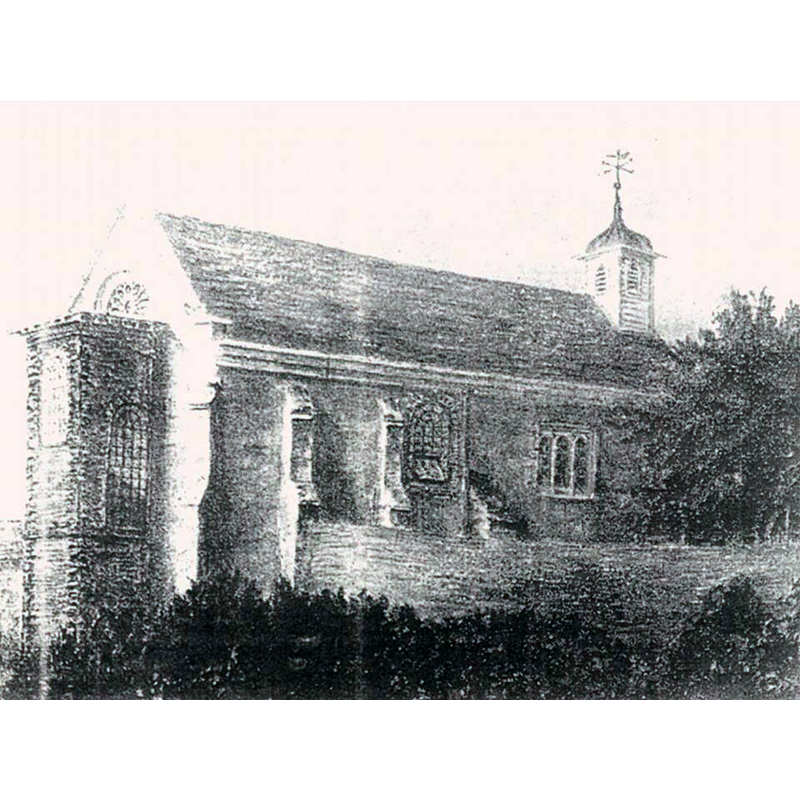Stratford nr. Bow / Bow / Brambele / Brambelegh / Brembeley / Bromley-by-Bow / Stratford at Bow / Stratford-le-Bow

Image copyright © Gordon Joly, 2008
CC-BY-SA-3.0
Results: 4 records
view of church exterior - detail
Scene Description: Source caption: "Late eighteenth-century engraving showing features in then surviving essentially Norman church"
Copyright Statement: Image copyright © Robert Wynn Jones, 2019
Image Source: digital image [original source not given] in Robert Wynn Jones' The Lost City of London - Before the Great Fire of 1666 site [https://lostcityoflondon.co.uk/2014/05/15/the-priory-of-st-leonard-stratford-at-bow/] [accessed 17 May 2019
Copyright Instructions: No known copyright restriction / Fair Dealing
view of church exterior - northeast view
Scene Description: Source caption: "Illustration of circa 1800 showing then surviving essentially Norman church"
Copyright Statement: Image copyright © Robert Wynn Jones, 2019
Image Source: digital image [original source not given] in Robert Wynn Jones' The Lost City of London - Before the Great Fire of 1666 site [https://lostcityoflondon.co.uk/2014/05/15/the-priory-of-st-leonard-stratford-at-bow/] [accessed 17 May 2019
Copyright Instructions: No known copyright restriction / Fair Dealing
view of church exterior - west view
Scene Description: The re-building of the badly damaged church at Stratford-at-Bow
Copyright Statement: Image copyright © Gordon Joly, 2008
Image Source: digital photograph taken 4 February 2008 by Gordon Joly [https://commons.wikimedia.org/wiki/File:Bow_Church_2008.JPG] [accessed 16 May 2019]
Copyright Instructions: CC-BY-SA-3.0
view of church exterior in context
Scene Description: Source caption: "Early twentieth-century photograph showing then surviving Victorian church"
Copyright Statement: Image copyright © Robert Wynn Jones, 2019
Image Source: digital image [original source not given] in Robert Wynn Jones' The Lost City of London - Before the Great Fire of 1666 site [https://lostcityoflondon.co.uk/2014/05/15/the-priory-of-st-leonard-stratford-at-bow/] [accessed 17 May 2019
Copyright Instructions: No known copyright restriction / Fair Dealing
INFORMATION
FontID: 05633STR
Object Type: Baptismal Font1?
Church/Chapel: ParishChurch of St Mary Stratford Bow [aka as St Mary-atte-Bow / St Mary and St Leonard's / St Mary and the Holy Trinity's]
Church Patron Saints: St. Mary the Virgin
Church Location: 224 / 230 Bow Rd, Bow / Poplar, London E3 3AH, UK
Country Name: England
Location: Greater London, South East
Directions to Site: Located off the A11,on an island, just W of the crossroads with the A12, and E of the B142; it is now part of Greater London, just W of Hackney; the nearest tube station is Bromley-by-Bow, District line
Ecclesiastic Region: Diocese of London
Historical Region: Hundred of Ossulstone -- formerly Middlesex
Font Location in Church: [cf. FontNotes]
Century and Period: 15th century, Perpendicular
Church Notes: originally the church of a Benedictine priory; later parochial -- ***NOT to be confused with St. Mary-le-Bow, off the S side of Cheapside, between St Paul's and Bank***
Font Notes:
Click to view
No individual entry for this Stratford found in the Domesday survey. The Victoria County History (Middlexex, vol. 1, 1969) notes: "The priory of St. Leonard, Stratford at Bow, first mentioned in 1122 [...] was a house of Benedictine nuns. [...] The priory stood near the banks of the Lea. The chapel of St. Mary in the priory church served as the parish church for the parish of St. Leonard, Bromley, and its site is indicated today by a small park lying about 200 yards south of Bow Bridge. The priory lay to the south of the church. [...] There are no means of determining the plan of the convent. The royal grant of 1537 mentions the house and site of the priory, and the church, 'steeple', and churchyard. [...] The 'steeple' disappeared, but the eastern limb of the church continued to be used for worship. The description by Lysons [...] and prints of the early 19th century [...] give little idea of the appearance of this part of the church in the Middle Ages. In 1805 the church was a small rectangular building, lighted by an haphazard collection of windows of indeterminate dates; the medieval floor appears to have been considerably lower than the ground level of 1805, [...] and the east window had been replaced c. 1700 by a primitive apse for the communion table. Inside there were signs that there had been a south aisle, but the most striking feature was the Norman choir arch, with dog-tooth ornament, at the west end. The arch had been blocked up and everything to the west of it had disappeared by 1805. The building as Lysons saw it survived until 1842, although in a dilapidated condition. In 1842-3 a new church in the neo-Norman style was erected on the site. [...] This was destroyed in the Second World War." Cox & Harvey (1907: 164) report a pre-Reformation baptismal font made of brick in this church. Listed in Bond (1908: 76) simply as a baptismal font made of brick. NB: a font from Henry V's time -i.e., 1387-1422- is identified in the parish church of St. Mary's at Stratford, Bow and Old Fort, Bow, aka, Stratford-le-Bow. The county for Bow / Stratford-le-Bow was given as Middlesex in the National Gazetteer of Great Britain and Ireland (London: Virtue, 1868). We have not been able to ascertain whether or not the font referred to in Cox & Harvey and in Bond is the one surviving at the parish church of Stratford St. Mary's -- the church in Stratford at Bow was practically destroyed in WWII bombings]. The entry for this church in Historic England [Source ID: 1065273] notes: "Parish Church. Possible C14 core, C15 tower, further rebuilding and restoration in early-C18, 1829, 1882, 1895 and the 1950s [...] Built as chapel of ease to Stepney (licence of 1311) and parish church from 1711. [...] Octagonal font with perpendicular tracery." The entry for the Priory of St Leonard Stratford-at-Bow in The Lost City of London - Before the Great Fire of 1666 site [https://lostcityoflondon.co.uk/2014/05/15/the-priory-of-st-leonard-stratford-at-bow/] [accessed 17 May 2019] notes: "The Priory was dissolved by Henry VIII in 1536, although the last Prioress, Sybil Kirke, was allowed to carry on living there for a while. At the time of the dissolution, the priory buildings included a Hall, a Parlour, a Kitchen, a Buttery, a Dorter, a Great Chamber, a Maid’s Chamber, further Chambers over the Parlour and the Buttery, a Brewhouse, a Malting House and a Barn as well as a Church, with all of the aforementioned and their contents realising a little over £100 (the valuable books from the priory were not sold but instead incorporated into the library at Westminster Abbey). After the dissolution, the priory church was partly demolished and modified to become the parish church of St Mary with St Leonard. In 1539, the remaining priory buildings were granted to Sir Ralph Sadler, who converted some of them into tenements that he leased out (one to William Huddleston, the former Abbot of Stratford Langthorne). In 1634, they passed to Sir John Jacob, who demolished all of them to make way for a new manor house, itself now no longer standing (Bromley House). By the end of the seventeenth century, only the church remained of the original priory, and for a while was used by Protestant Huguenots fleeing religious persecution in their native France (after their religious and civil liberties were removed by the Revocation of the Edict of Nantes in 1685). The church was then rebuilt and refounded in 1842-3. Sadly, it was almost completely destroyed by enemy bombing in 1941. Essentially all that survives of it today is part of the churchyard, sandwiched between the busy Blackwall Tunnel Approach Road and Bromley High Street, and containing some somewhat neglected and overgrown graves, appearing to date from the eighteenth and nineteenth centuries." The badly-damaged church was re-built in the 1950s.
COORDINATES
Church Latitude & Longitude Decimal: 51.5288, -0.0167
Church Latitude & Longitude DMS: 51° 31' 43" N, 0° 1' 0" W
MEDIUM AND MEASUREMENTS
Material: brick, brick
REFERENCES
Victoria County History [online], University of London, 1993-. Accessed: 2019-05-17 00:00:00. URL: https://www.british-history.ac.uk.
Bond, Francis, Fonts and Font Covers, London: Waterstone, 1985 c1908
Cox, John Charles, English Church Furniture, New York: E.P. Dutton & Co., 1907


